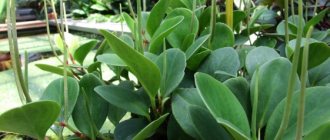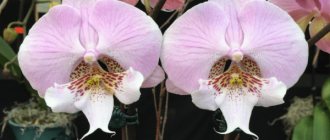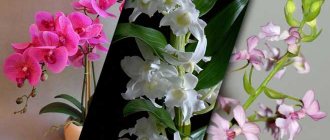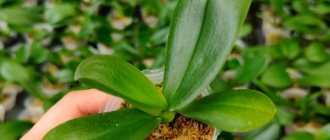Peculiarities
It is quite possible to grow an orchid without soil only if the roots of the flower are accustomed to a constant humid environment.
After all, the tree bark and other additional components play a secondary role, as they are necessary to support the orchid. But if you resort to using a skewer or something else, then there is no need for a soil mixture.
In winter, an orchid grown without soil needs to be watered less often (you can find out how to care for an orchid in the autumn-winter period here). And in the spring, when the flower begins to actively grow, increase the frequency of moisturizing. In addition, it is important to monitor the lighting.
For orchids indoors, any window is suitable, except the south one, since direct sunlight is destructive for phalaenopsis (read more about where it is better to place an orchid and where not to keep a flower).
Preparing the container and substrate
It is convenient to keep an orchid in a transparent container. This applies to all growing methods, including in water. Glass vases are not suitable for two reasons:
- Cold material for orchid roots.
- It is impossible to make holes for air circulation and water level control.
Therefore, they use plastic pots, which can be bought at a flower shop. You can take an ordinary transparent plastic bucket, and to hide its origin, hide it in a decorative flowerpot. 3 holes with a diameter of 6 mm are made in the wall of the pot at the level of a quarter of its height. Use a heated soldering iron or screwdriver.
Inert substances that do not rot in water are used as a substrate:
- Styrofoam.
- Expanded clay.
- Pine bark.
- Perlite.
- Diatomite
- Greenmix, which consists of mineral wool with the addition of perlite.
Many gardeners prefer expanded clay. Thanks to thin capillary channels, the water itself rises to the roots, ensuring its circulation. When using greenmix and diatomaceous earth, you need to especially carefully monitor the liquid level in the container. If there is not enough of it, the substrate will begin to draw moisture from the roots of the orchid.
Often gardeners mix different types of substrate in arbitrary proportions.
Fertilizers for growing orchids hydroponically are purchased at the store. A wide selection makes it possible to choose what is most suitable for the orchid’s development phase (rooting, flowering).
Planting an orchid in water involves several stages:
- The roots are cleaned and washed in cool water to remove soil residues.
- Pour the substrate into the prepared pot so that it reaches the holes in the wall.
- Install the orchid by straightening the roots.
- Pour in the nutrient solution.
- Add the substrate so that there is one and a half centimeters left to the top of the dish.
Planting rules are adjusted depending on what substrate is used:
- If it is expanded clay itself, pour it to half the container, install the flower, then fill it to the top.
- When using perlite, a layer of expanded clay is placed on the bottom, the plant is placed and covered with perlite 1 cm from the top. Immerse in water to compact it.
- When planting in diatomaceous earth, a layer of expanded clay is placed on the bottom, reaching the holes. The flower is installed, covered with diatomaceous earth, and a layer of expanded clay is placed on top.
- Green Mix is poured on top to compact it. Remaining water is removed through the holes. Then the nutrient composition is poured.
In summer, the water height should be 4 cm, in winter it is reduced to 1 cm. The length of daylight should be at least 12 hours. For additional illumination, phytolamps are used.
Advantages and disadvantages
Growing an orchid without soil has the following advantages:
- You can prevent the flower from rotting or the development of parasites in the soil. This is extremely important, since rot in the root system is a common problem for orchids.
- By growing a flower without soil, you can avoid transplanting, which is a real stress for the plant.
- Dissolving useful components in liquid will prevent their shortage or excess.
- The absence of soil will allow the plant to remain strong and healthy, as it will receive the necessary amount of beneficial microelements, so the roots will not dry out.
When growing orchids, an open automatic system is used, which reduces the time spent caring for the flower.
just important not to forget to add water from the irrigation system when necessary .
Thanks to this method, the orchid will no longer need watering for 2 weeks, and it will not harm it in any way.
As for the disadvantages of the method, there is only one - it is difficult to care for. Because of this, the appearance of the flower begins to suffer, as its leaves turn yellow and fall off, and the root system rots.
Advantages of this planting method and possible problems
This method of growing orchids, such as hydroponics, has a number of advantages:
Using this technology, it is quite possible to prevent plant rotting or the occurrence of parasites in the soil. This property is of great importance, because rot in the root system is a common problem for this representative of the flora.- By growing plants in this way, you can avoid orchid transplants.
- Dissolving beneficial microelements in liquid helps prevent their deficiency or excess.
- The absence of soil allows the crop to remain strong and healthy, since the plant receives the required amount of beneficial microelements, as a result of which its roots do not dry out.
At the same time, when growing orchids, an open automatic type system is used , which will reduce the time required to care for flowers. The main thing in this case is not to forget to add water after a certain period of time. Thus, the need to water the orchid disappears for several weeks, and this will not harm the plant at all.
As for difficulties in caring for orchids, flower growers can only encounter them if the rules for caring for the plant are violated. The first such problem may be yellowed leaves. It's one thing when old leaves turn yellow and fall off. The situation is completely different if young leaves begin to turn yellow. This may happen if:
- Over-watering has occurred. Then, along with the yellowing leaves, you can observe the process of rotting roots.
- An overdried substrate can also lead to leaf wilting. This can happen when the plant is not sprayed and the air in the room is too dry.
- Direct sunlight in the summer can cause such a negative reaction.
- A draft or cold room in winter can cause yellowing of the leaves.
Important! In addition to the leaves, a problem may also arise in the root system of orchids. Here you can see how the roots simply begin to rot due to waterlogging. In this case, the plant requires urgent transplantation.
Also, orchids may sometimes not please the eye with their blooms. This may be due to lack of lighting. And finally, the plant may suffer from the negative effects of pests and some diseases. In the first case, we can talk about mealybugs or spider mites.
What is used instead of soil?
The orchid feels great even not in soil saturated with humus, but on the trunks, branches, and roots of some tree. The components necessary for the development of a flower are not obtained from the soil at all . The atmosphere remains the source of nutrition.
An orchid needs soil only so that it can somehow gain a foothold and stay in a certain area. So when choosing components to be used instead of soil, you need to take into account their permeability to moisture and air.
In most cases, the main component for a homemade soil mixture is tree bark. You can pick it with your own hands or purchase it at a specialized store. Most often, gardeners choose pine bark, although the bark of oak and conifers is excellent. To assemble it, you will have to use sawn logs or dead wood.
To ensure the safety of the plant and protect it from pests and bacteria, pieces of bark must be cleaned of softened areas and dried thoroughly .
In addition to bark, flower growers actively use sphagnum moss as soil. Its main purpose is to make the soil loose, retain moisture without compacting the soil, absorb harmful salts and have a bactericidal effect.
In addition to tree bark and moss, expanded clay and activated carbon, which also has disinfectant properties, are suitable for orchids.
We invite you to watch a video about the types of soil for growing orchids:
Features of the technique
Most orchids are epiphytes that live in a “suspended” state. Clinging to the bark of trees with aerial roots, they receive moisture from the air or from streams of rainwater. They draw useful substances from dying layers and rotted leaves.
It is impossible to recreate a tropical climate in a residential area, but certain conditions can be brought closer to natural ones. At the same time, the presence of a substrate is not the most important thing when keeping an orchid. It is much more important to ensure uniform moisture, nutrition and air exchange of the roots.
There are many ways to cultivate - in bark, on blocks, hydroponically, and even with bare roots in a glass pot. The last option is not known to many, but it is very interesting, so it is worth paying special attention to it.
How to choose a glass vase
Wide, stable vessels of spherical and cylindrical shape are preferred for placing orchids. Vases in the shape of a cube or glass are suitable. You can use double planters, in which the inside contains holes for drainage.
Definitely won't fit:
- narrow, cylindrical or rectangular containers - the roots will be cramped in them;
- pots that are too high - the plant “sinks” in them along with the leaves and flower stalks.
Before buying a vase, imagine your orchid inside: is there enough space for roots and how will the leaves be arranged? Consider the possibility of securing the plant in a vertical position.
It is important to choose the most suitable place in the house. The plant should not be cooled under a window (it may rot) and should not be roasted in the sun (the greenhouse effect will ruin the roots).
What varieties are suitable
Among orchids, species that do not require a dry and cool dormant period or have massive roots are better suited for cultivation in vases.
The choice of variety depends on the planting method:
- Into the water - phalaenopsis and vanda.
- Expanded clay includes phalaenopsis, dendrobium, vanda, cattleya, oncidium, coelogina, phragmipedium.
- In perlite - orchids with thin roots - dendrobium, oncidium, cattleya.
- In large diatomite - vanda; in the middle - phalaenopsis, dendrobium, slippers.
In what container should the plant be kept?
When growing an orchid without soil, the hardest part is choosing the right pot. For this plant, it is worth choosing a container of this type and structure so that the flower has a place to develop, does not dry out and is not subject to the harmful effects of dry air in the room where the plant is kept. When choosing a pot for growing without soil, you should give preference to glass vases or plastic and ceramic containers. In addition, they must meet the following criteria:
- Containers must have water drainage.
- The size of the pot and the size of the plant should match each other.
- The volume of the container should be such that the root system of the plant can be located there freely and does not touch the walls.
We invite you to watch a video about choosing a container when growing an orchid in an open system:
Containers for growing plants
As has already become clear, an orchid is a plant that does not grow in the ground, but is attached to other plants by its roots. Therefore, it is important to choose the right container for growing the specified representative of the flora. Otherwise, there is a risk that its root system will begin to rot.
Pots for the specified representative of the flora should be chosen of a type and structure that would allow the orchid to develop, and also not dry out and not be subject to the negative effects of dry air in the room where the plant is located.
When choosing pots, preference should be given to those made of glass, plastic or ceramic containers. In addition to the above requirements, orchid pots must meet the following conditions :
- they must have a drain for water;
- the volume of the container and the size of the plant must correspond to each other;
- The volume of the pot should be such that the root system of the orchid is located freely and does not touch the walls.
Difference in cultivation
Using this method of growing orchids, you need to take a more careful and responsible approach to the care process.
Unlike the traditional method, in this case there is no need to select soil or prepare it yourself, which reduces time and money. But there are more stringent requirements for growing conditions: suitable humidity, timely watering.
And the most important difference is that an orchid grown in soil gets sick much less often than one for which the soil mixture is not used.
We invite you to watch a video about the difference between growing orchids in closed and open systems:
Hydroponic technology
Hydroponics (using nutrient solutions) as a method of growing plants originated more than 200 years ago. Landscape designers use its principles to create roof gardens and vertically arranged ever-blooming flower beds. Gardeners value it for its compact equipment for greenhouses and high crop yields.
Hydroponic techniques are increasingly attracting orchid growers. The fact that there is no need to give up the substrate mixtures that lovers of tradition value so much. And at the same time, the advantages of open systems are preserved. Care involves regularly adding a nourishing mixture and monitoring the condition of the flowers.
Basic principles and advantages
The technology helps to successfully cultivate any crops - from exotic plants to various mosses. With its help, rooting of cuttings and germination of seeds is ensured.
The fundamental principle is adjustment to the needs of the plant. The root system is placed directly in the solution or in a porous inert base as a fixing support. Moisture is enriched with oxygen, micro- and macroelements (in an easily digestible form in certain proportions). Circulating through the capillaries, it irrigates and nourishes them.
Important! The method is not suitable for tuber crops. At high humidity or temperature, rotting may begin in the tubers.
Many negative factors that are inherent in cultivation in the ground, which contains harmful elements and there is a risk of infection by microorganisms, are eliminated. The inert base guarantees the absence of any pests. Consequently, there is no need for treatment with pesticides. The root in such favorable conditions is healthier and more developed.
Having received everything it needs, the plant redirects its forces to the growth of the above-water part. The optimal balance of additives becomes possible thanks to their precise dosage. In gratitude, ornamental pets bloom profusely and for a long time.
The cost-effectiveness of the technique is no less important. The cost of purchasing soils is reduced, which now lasts 3-4 times longer. Abundant watering is replaced by adding liquid several times a month. In this case, only half the norm is required. In winter, the normal height of the liquid may not exceed 1 cm, in summer - about 4. The spent composition is not drained - it can be used to water other flowers.
Device
For amateur gardening, hydroponic systems from different manufacturers are offered. They already have optimal pH settings and oxygen saturation. The installation works almost autonomously after just one adjustment. The problem of adding water is solved by installing a submersible pump with a timer or a circulation system with an aerator. Caring for a plant using professional equipment becomes a pleasure.
Advice! To obtain a slightly acidic reaction and “softness” at home, ordinary water can be passed through a membrane filter, frozen or mixed with distilled water. Temporary hardness can be reduced by boiling.
You can make a similar system yourself using pots from a flower shop. For example, transparent plastic or ceramic, if there is a fear that glass flowerpots will cool the roots too much. Plastic can be “hidden” in decorative, stable flowerpots, preferably not allowing light to pass through. Minimal exposure to sunlight will prevent “blooming”. The walls and bottom of the internal tank are provided with holes with a diameter of no more than 6 mm to supply power and oxygen.
Substrate mixtures
Non-decomposing mineral components are used as substrate bases for orchids: expanded clay, perlite, zeolite or greenmix. All of them are porous, have high capillary conductivity, and are chemically inactive. With proper use, they can last from 6 to 10 years without replacement.
- Expanded clay pellets are porous clay, fired at 1200C, in the form of round and irregularly shaped granules. It is not moisture-intensive, so it must be constantly moistened so that the root system does not dry out. Suitable for hydroponic systems where frequent watering is required. Sprinkled on the surface, it promotes less evaporation and protects against mold. Works for up to 6 years, then begins to decompose. Over time, salts appear on the pellets due to constant watering and spraying. In this case, as well as before the first use, it must be thoroughly rinsed.
- Perlite is a natural, eco-friendly material that is safe for flowers. It becomes super light after industrial expansion. It stores heat well, smoothes out temperature fluctuations, and prevents freezing. Absorbs all components perfectly, then gradually, smoothly releases them. Just like clay, it is not subject to decomposition by bacteria and fungi. Excellent for rooting, increases their aeration.
Important! Perlite (foam glass) contains dust that is harmful to human lungs. When working with it, it is better to wear a respirator. After purchase, pour in, stir, then drain the fine fraction.
- Zeolite (kieselguhr, diatomite) is a solid porous aluminosilicate. When watering it characteristically “hisses”. Used in aquarium farming and for industrial water purification. For orchids, only magmatic zeolite is suitable, which does not dissolve in liquid, does not form lumps and does not contain any additives. Like perlite, it protects plants from stressful temperature changes.
- A combination of of mineral wool (moisture-absorbing and water-repellent) with the addition of an aerating element - perlite. Suitable for those who prefer cool conditions (such as dendrobium). The Greenmix complex, on the one hand, cools the root system and prevents its rotting, on the other hand, it prevents drying out and increases the humidity around the plant.
Professional flower growers often mix different types of substrate additives in arbitrary proportions. Thus, they obtain their own version, suitable for the climate and a specific plant.
How to properly care?
This interesting way of growing an orchid requires more careful care of the plant, which consists of the following:
- Avoid high humidity in the room where the flower is located.
It can withstand short droughts much more easily. To control the level of humidity, it is necessary to grow the orchid in a container with transparent walls. Then it will be possible to visually determine whether the orchid without soil needs watering. - Spray the roots and above-ground parts of the plant daily with soft water using a spray bottle. This will allow you to achieve the required level of humidity.
- Lighting is no less important for the growth and development of a flower. Daylight hours should be 10 hours. The sun's rays can be seen by artificial lighting using fluorescent lamps.
- During the day, the air temperature should be between 18-27 degrees, and at night – 13-24 degrees.
By following the recommendations presented, there should be no complications or difficulties in care , and the orchid itself will delight the eye with its flowering and luxurious appearance.
Proper care
Looking ahead, it should be noted that there is no fundamental difference in caring for orchids planted in the ground and plants that grow from other components of the substrate. Therefore, to ensure comfortable conditions for the plant, it will be quite enough to adhere to the general principles of its maintenance.
So, you should avoid excessive humidity when caring for an orchid. It is much more able to withstand short droughts. From the point of view of controlling humidity levels, it will be excellent if the orchid grows in a container with transparent walls. This way you can visually determine whether an orchid without soil needs watering.
Advice! It is also recommended to spray the roots and above-ground parts of the plant daily with soft water using a spray bottle. This will help ensure the required level of humidity.
As for lighting, the duration of daylight for an orchid should be at least 10 hours. You can replace the sun's rays with artificial lighting - fluorescent lamps . If we talk about the temperature regime, then the overwhelming number of varieties of the designated plant feels quite comfortable during the day at a temperature of 18-27ºC, and at night – 13-24ºC.
If you follow all the suggested recommendations, then no difficulties or difficulties should arise when caring for the plant. It will only please the eyes of the inhabitants of the house.
Difficulties
Any difficulties may arise if you do not follow the rules for caring for your orchid. The most common problem remains associated with the desire of the leaf blade, as a result of which the leaves simply fall off. But it’s one thing when this is a natural process and old leaves fall off, but this can happen to young ones for the following reasons:
- overmoistening - along with the yellow leaves, the process of rotting of the root system occurs;
- overdried soil is a common cause of leaf wilting; this occurs if the plant is not sprayed and the air in the room is not humidified;
- direct sunlight - in the summer can lead to the development of such a negative phenomenon;
- draft or cold room in winter.
In addition to yellowing of the foliage, problems arise in the root system. In this case, the roots begin to rot due to waterlogging. You can still save the plant if you replant it.
In order for an orchid to delight with lush flowering for many years, you first need to find out what to do after purchasing a flower, then study in detail all the available information about the purchased variety, the conditions for keeping the plant, the rules for replanting, pruning and fertilizing.
Growing an orchid without soil is an interesting activity for every gardener . But there are a number of points here, without which the flower risks dying. So only experienced people should choose this growing method to prevent problems in the future.
Contents in flasks
The difference lies not only in their beautiful blooms, but also in their breeding methods. While many flowers grow on the ground, orchids grow from tree bark, clinging to it. They obtain useful components and moisture with the help of aerial roots. Moisture comes from the air or fog, and useful components from their residues that accumulate in the tree bark. But this process occurs in the humid tropics, where the habitat for orchids is very suitable. It is impossible to create such an atmosphere in indoor conditions. There is more than one method for growing an orchid:
- growing in water - hydroponics;
- orchid without substrate and liquid;
- breeding in soil.
If the roots of the plant are constantly in liquid, they will begin to rot. Therefore, they should not be completely submerged, but rather be above the liquid. It is not necessary to switch to keeping it in a flask right away, especially for the flower itself:
- First you need to pull it out of the ground, clean the roots, put it in water for a couple of days, and then dry it the next day. You do not need to drain the liquid completely, but so that one centimeter of the roots are still immersed in it.
- After a week, the orchid can be left in the water for several days, but one day should be allowed to dry.
- Afterwards, leave the phalaenopsis in the water for the entire time, changing it and observing the condition of the roots. If they change color to silver, it means the flower needs to be watered.
At this time, the growth of new aerial roots will be noticeable, and green shoots will begin to appear on the old ones.
Note!
With this method, growing can be difficult due to rot on the roots. To cope with it, the flower needs to be taken out of the water for a day and the roots treated with a fungicide.
If algae appears on them, then you should not get rid of them, as this helps air exchange. A small part of the roots dies off if the habitat has changed to aquatic, and instead of them, those adapted for the plant to stay in water appear.
To prevent the appearance of fungus, you need to use semi-hydroculture - an unusual substrate that does not provide the flower with any nutritional components, but keeps it in a standing position. The flower receives all its nutrition through fertilizers, which are diluted in water. They are easily digestible, and therefore do not waste a lot of energy, directing it to development.
Caring for an orchid in water
Orchids grown in water require constant monitoring and care:
- The temperature in winter is maintained no higher than 25 degrees. To form flower buds, lower the temperature for two weeks to 15 degrees.
- Orchids love moist air. They feel best at a humidity of 60-75%. This is the main problem in growing a plant, because it cannot be created at home. Especially high humidity is needed during the formation of rosettes. Most of the grown orchid varieties grow well at 35-40%. Growing in water solves the moisture problem to some extent. Water evaporates under the influence of high temperature, and the humidity near the roots increases.
- The flower loves fresh air, but does not tolerate drafts. Therefore, you need to install the pot in places where there is no flow of fresh air from the window. If there is no natural ventilation, you can turn on a fan or air conditioner. In summer, you can grow an orchid on the balcony if it does not receive direct sunlight. Place the dishes with the orchid in partial shade. The sun's rays can leave burns on its leaves. The same applies to placement in the room.
- Water it with charcoal-filtered soft water, the temperature of which is about 23°C. It is better to use rainwater.
- When grown in a substrate, most of which is expanded clay, the pebbles are first sprayed and then watered. Using all materials except expanded clay, the roots of the orchid are first sprayed and then watered, running water along the walls of the dish.
- Do not allow orchid leaves to fall into water. They can rot there. Drops that fall on the leaves during care are removed with a napkin. Sometimes they are wiped with a damp sponge without leaving any drops. Constantly inspect and clean the holes in the dishes.
- Change the solution in the pot every 3 days. Once a month, wash the pot with running water. During the procedure, the roots are wiped, dried for 6 minutes, then immersed in a new composition.
- If the edges of the leaves are wrinkled, this means that the room is very hot, the difference between night and day temperatures is small or completely absent. Phalaenopsis does not need temperature differences.
- Sometimes an orchid grows roots and leaves, but does not bloom. It is recommended to make a difference in temperatures between day and night within 8 degrees.
With this method of growing orchids, they are not protected from flying pests and their larvae that feed on the plant sap. This is a whitefly butterfly that can be easily seen on the leaves of the plant. You can fight it by treating it with a solution of laundry soap. Dilute it with water (6 parts) and wipe the leaves.











